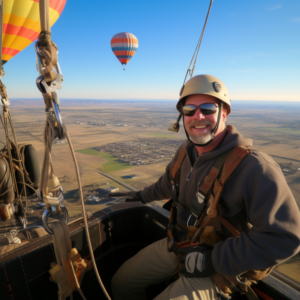Welcome to our special hot air balloon blog, where we delve into the captivating art of balloon piloting. In this article, we will explore the intricate skills and techniques required to pilot a balloon with mastery and finesse. As experienced balloon pilots, we understand the unique blend of artistry and technical expertise involved in maneuvering these graceful aircraft. Join us as we unravel the secrets behind the art of balloon piloting, revealing the skills, knowledge, and passion that drive these aerial artisans.
Section 1: Understanding the Principles of Ballooning
o truly master the art of balloon piloting, a deep understanding of the principles of ballooning is essential. We will explore the science behind hot air balloons, including the concept of buoyancy, the role of temperature differentials, and the influence of wind on flight dynamics. By comprehending these fundamental principles, pilots can navigate the skies with precision and confidence.
Section 2: Weather Forecasting and Analysis
One of the key skills for a balloon pilot is the ability to interpret weather forecasts and analyze atmospheric conditions. We will discuss the importance of assessing wind speed and direction, temperature variations, and other meteorological factors that impact balloon flight. By developing expertise in weather analysis, pilots can make informed decisions regarding flight routes, launch times, and ensure the safety of passengers and crew.
Section 3: Balloon Handling and Navigation Techniques
Mastering the art of balloon piloting requires impeccable balloon handling and navigation skills. We will delve into the techniques of inflating and deflating the balloon, controlling altitude through burner operation, and maneuvering the balloon using venting and rotational control. Additionally, we will explore navigation techniques, such as utilizing wind layers to change course and utilizing landmarks for orientation. These skills enable pilots to navigate the skies with finesse and precision.
Section 4: Decision-Making and Risk Assessment
Balloon piloting demands sound decision-making and risk assessment abilities. We will discuss the importance of evaluating flight conditions, assessing potential hazards, and making informed decisions regarding flight plans and emergency procedures. The art of balancing calculated risks with the safety of passengers and crew is crucial for successful balloon piloting. We will also emphasize the significance of continuous learning and staying updated with industry standards and best practices.
Section 5: Communication and Leadership Skills
Effective communication and leadership skills are vital for a balloon pilot. We will explore the art of clear and concise communication with passengers, crew members, and air traffic control. Building trust and fostering a calm and reassuring environment onboard are essential for a memorable and enjoyable flight. Additionally, we will discuss the importance of teamwork, delegation, and decision-making under pressure.
Balloon piloting is a captivating art that requires a unique combination of skills, knowledge, and passion. By understanding the principles of ballooning, mastering weather analysis, honing balloon handling and navigation techniques, making informed decisions, and developing excellent communication and leadership skills, pilots can elevate their craft to new heights. As you witness the grace and beauty of a hot air balloon floating through the sky, remember that behind its flight lies the artistry of skilled pilots. So, entrust yourself to the hands of these aerial artisans, and embark on an unforgettable journey into the enchanting world of balloon piloting.



